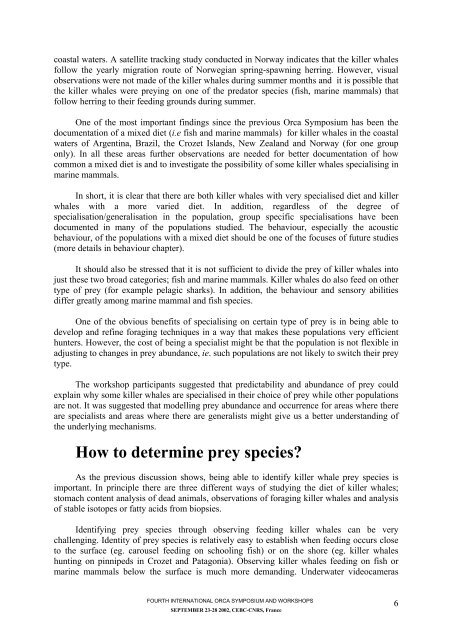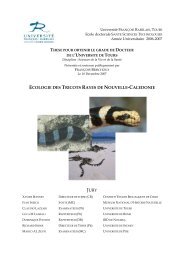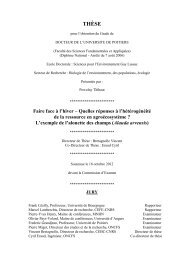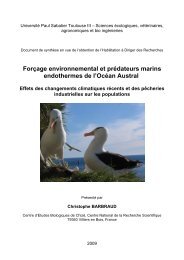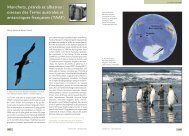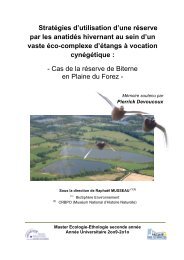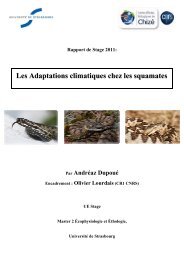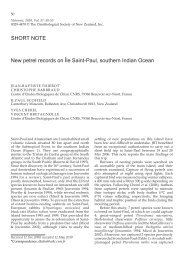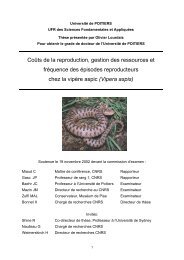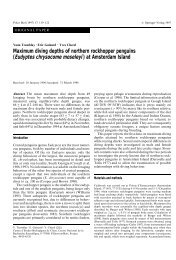Fourth International Orca Symposium and Workshop - CEBC - CNRS
Fourth International Orca Symposium and Workshop - CEBC - CNRS
Fourth International Orca Symposium and Workshop - CEBC - CNRS
Create successful ePaper yourself
Turn your PDF publications into a flip-book with our unique Google optimized e-Paper software.
coastal waters. A satellite tracking study conducted in Norway indicates that the killer whales<br />
follow the yearly migration route of Norwegian spring-spawning herring. However, visual<br />
observations were not made of the killer whales during summer months <strong>and</strong> it is possible that<br />
the killer whales were preying on one of the predator species (fish, marine mammals) that<br />
follow herring to their feeding grounds during summer.<br />
One of the most important findings since the previous <strong>Orca</strong> <strong>Symposium</strong> has been the<br />
documentation of a mixed diet (i.e fish <strong>and</strong> marine mammals) for killer whales in the coastal<br />
waters of Argentina, Brazil, the Crozet Isl<strong>and</strong>s, New Zeal<strong>and</strong> <strong>and</strong> Norway (for one group<br />
only). In all these areas further observations are needed for better documentation of how<br />
common a mixed diet is <strong>and</strong> to investigate the possibility of some killer whales specialising in<br />
marine mammals.<br />
In short, it is clear that there are both killer whales with very specialised diet <strong>and</strong> killer<br />
whales with a more varied diet. In addition, regardless of the degree of<br />
specialisation/generalisation in the population, group specific specialisations have been<br />
documented in many of the populations studied. The behaviour, especially the acoustic<br />
behaviour, of the populations with a mixed diet should be one of the focuses of future studies<br />
(more details in behaviour chapter).<br />
It should also be stressed that it is not sufficient to divide the prey of killer whales into<br />
just these two broad categories; fish <strong>and</strong> marine mammals. Killer whales do also feed on other<br />
type of prey (for example pelagic sharks). In addition, the behaviour <strong>and</strong> sensory abilities<br />
differ greatly among marine mammal <strong>and</strong> fish species.<br />
One of the obvious benefits of specialising on certain type of prey is in being able to<br />
develop <strong>and</strong> refine foraging techniques in a way that makes these populations very efficient<br />
hunters. However, the cost of being a specialist might be that the population is not flexible in<br />
adjusting to changes in prey abundance, ie. such populations are not likely to switch their prey<br />
type.<br />
The workshop participants suggested that predictability <strong>and</strong> abundance of prey could<br />
explain why some killer whales are specialised in their choice of prey while other populations<br />
are not. It was suggested that modelling prey abundance <strong>and</strong> occurrence for areas where there<br />
are specialists <strong>and</strong> areas where there are generalists might give us a better underst<strong>and</strong>ing of<br />
the underlying mechanisms.<br />
How to determine prey species?<br />
As the previous discussion shows, being able to identify killer whale prey species is<br />
important. In principle there are three different ways of studying the diet of killer whales;<br />
stomach content analysis of dead animals, observations of foraging killer whales <strong>and</strong> analysis<br />
of stable isotopes or fatty acids from biopsies.<br />
Identifying prey species through observing feeding killer whales can be very<br />
challenging. Identity of prey species is relatively easy to establish when feeding occurs close<br />
to the surface (eg. carousel feeding on schooling fish) or on the shore (eg. killer whales<br />
hunting on pinnipeds in Crozet <strong>and</strong> Patagonia). Observing killer whales feeding on fish or<br />
marine mammals below the surface is much more dem<strong>and</strong>ing. Underwater videocameras<br />
FOURTH INTERNATIONAL ORCA SYMPOSIUM AND WORKSHOPS<br />
SEPTEMBER 23-28 2002, <strong>CEBC</strong>-<strong>CNRS</strong>, France<br />
6


